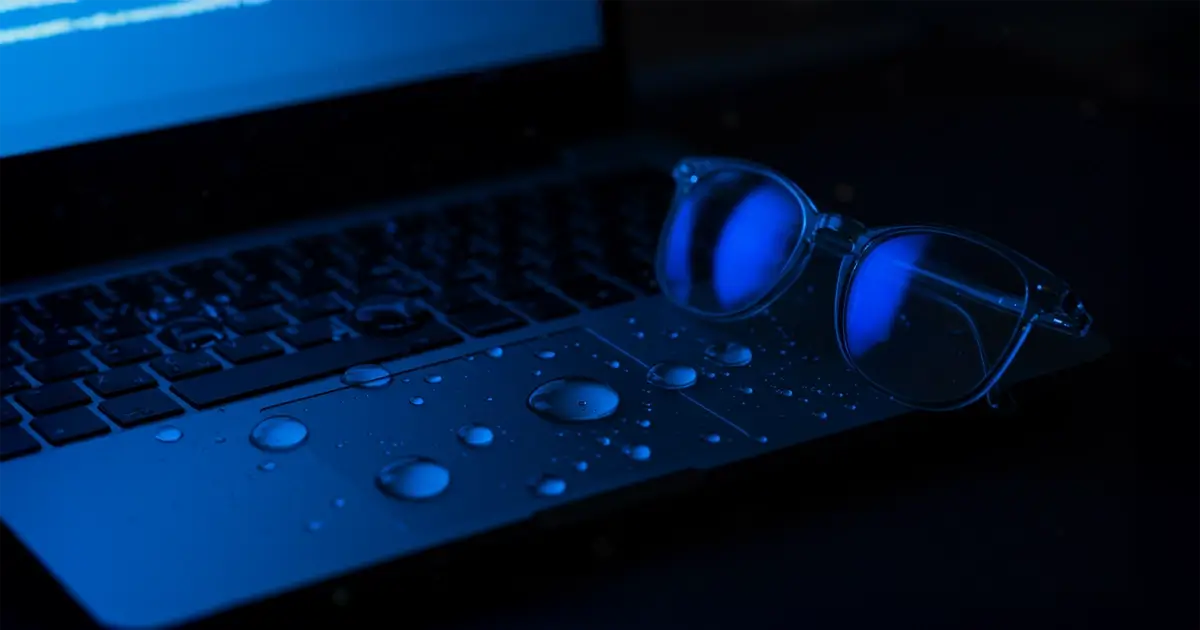Scrolling through skincare feeds, I keep seeing "blue-light blocking" creams shouting for attention, but does phone glow really hurt our complexions? Today I weigh the actual science against clever branding, weave in expert tips, and promise a breezy 12-minute read.
What Exactly Is Blue Light?
Blue light is a high-energy slice of visible light, sitting between 400 and 490 nanometres, that pours from the sun and every glowing screen in our homes. I like to picture it as the enthusiastic toddler of the light family, always moving and bumping into things. Because of that energy, researchers worry it may jostle skin cells enough to spark trouble.
Daylight delivers far more blue light than laptops, yet devices keep it inches from our faces for hours. The dose difference matters: eight hours outside under clear sky equals roughly 1 130 times the blue light from checking email for the same span. Context is everything.
Scientists measure blue-light exposure in joules per square centimetre. Most clinical setups blast skin samples with doses far beyond daily screen habits, which helps them spot changes fast, but can blur real-world relevance. Hold that thought, we will revisit it in the next section.
How Strong Is the Scientific Evidence on Skin Damage?
A 2020 Journal of Investigative Dermatology study found that bursts of blue light triggered longer-lasting pigmentation in deeper skin tones compared with UVB, raising fair concern for hyperpigmentation sufferers. However, the exposure equalled ninety minutes of midday summer sun, not a Netflix binge on the couch.
Another paper from Harvard Medical School's photobiology unit noted that blue light can fuel reactive oxygen species, but the spike was modest and faded once antioxidant systems kicked in. Translation: healthy skin with good barrier function usually puts out the fire before damage spreads.
The American Academy of Dermatology reviewed sixteen trials and concluded evidence is "emerging yet inconclusive," especially for fair skin types. That cautious wording reminds me of the friend who always says "maybe" when asked to join brunch. Possible, but don't clear your calendar.
Lab Data Versus Real-Life Skin
Most blue-light experiments use isolated keratinocytes or reconstructed skin, not volunteers watching cute cat videos. Without blood flow, sweat, or sebum, those samples lack the self-repair tools living tissue enjoys. This gap explains why dramatic petri-dish findings rarely show up at dermatology clinics.
Who Might Be More Vulnerable?
People dealing with melasma, post-inflammatory marks, or darker Fitzpatrick types have melanocytes primed to react faster. If pigment frustration is your daily companion, blue-light caution makes sense. For the rest of us, standard sun care and antioxidants already cover most bases.
The Marketing Machine Behind Blue Light Products
Beauty brands sniffed a fresh fear and moved quickly. Serums now flash "HEVL shield" labels, and tinted sunscreens brag about iron oxides that bounce blue wavelengths. Price tags flutter upward like confetti at a wedding, even when formulas barely differ from regular moisturisers.
I sifted through thirty launches this year and noticed recurring ingredients: niacinamide, lutein, and algae extracts. Funny thing, these were skin darlings long before laptop glare became a headline. Companies simply renamed benefits to ride the wave. One brand even printed a pixel icon on its jar, a bold graphic but scientifically empty.
If you already apply broad-spectrum SPF and an antioxidant serum - peek at my earlier post on antioxidant blends fighting urban stress - you likely tick the same protection boxes the "blue-light elixirs" advertise. Rebranding, meet reality check.
Practical Ways to Stay Chill About Exposure
Now, here is the fun part: tiny tweaks can lower screen glare without emptying wallets. Remember, sunlight still rules the blue-light throne, so sun-smart habits pull double duty.
- Shift device settings to night mode or warm tone after dusk. Your eyes relax, and melatonin thanks you.
- Place screens at least thirty centimetres from your face. The inverse-square law means intensity drops fast with distance.
- Wear broad-spectrum SPF15 or higher during daylight desk time if you sit by a bright window. No need for special filters.
- Layer an antioxidant serum each morning. Vitamin C, green tea, or resveratrol mop up stray radicals before they misbehave.
- Take screen breaks every hour. Stretch, sip water, maybe laugh at a dog meme - I promise your group chat will survive.
I follow these steps and still clock too many late-night emails, yet my skin barrier remains calm. Proof that prevention can be simple, not stressful.
By the way, if you ever catch me wearing SPF indoors at midnight, feel free to stage an intervention. My partner already jokes that I am the only person who reorganises sunscreens like books by genre.
FAQ
Does blue light age skin faster than UV?
Current evidence shows ultraviolet causes far more collagen breakdown. Blue-light damage is subtle and mostly tied to pigmentation rather than deep wrinkles.
Is a blue-light screen filter enough to protect my face?
Filters lower eye strain, yet skin receives reflection from the room and daylight, so classic sun care and antioxidants remain important.
Do I need a special "blue-light sunscreen"?
If your regular sunscreen offers broad-spectrum coverage and iron oxides, you are already set. Extra labels rarely add new technology.
Can blue light worsen acne?
No strong data links everyday device light to breakouts. Some clinic-grade blue-light treatments actually calm acne bacteria, but the intensity is far higher than phones emit.
Are darker skin tones at greater risk?
Darker tones can experience lingering pigment changes after intense blue-light exposure, so consistent antioxidant use and sun protection are wise.
Conclusion
Blue-light damage is a real scientific topic, yet day-to-day risk from screens remains small for most people. Sensible sun habits, antioxidant layers, and occasional device tweaks beat flashy marketing claims.
Have thoughts or experiences to share? Drop them below, and I will happily chat back. See you in the next post - until then, take good care of your skin!


Comments (0)
No comments yet - be the first to share your thoughts!
Leave a Reply
Your email address will not be published. Required fields are marked *